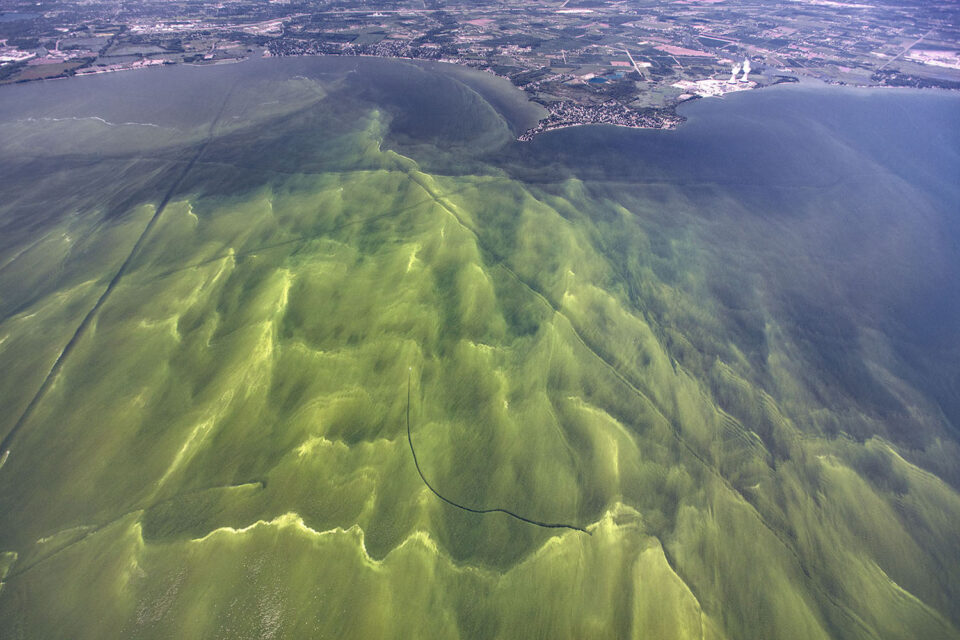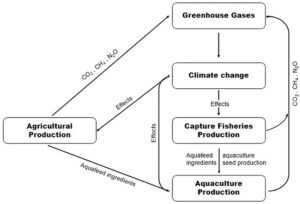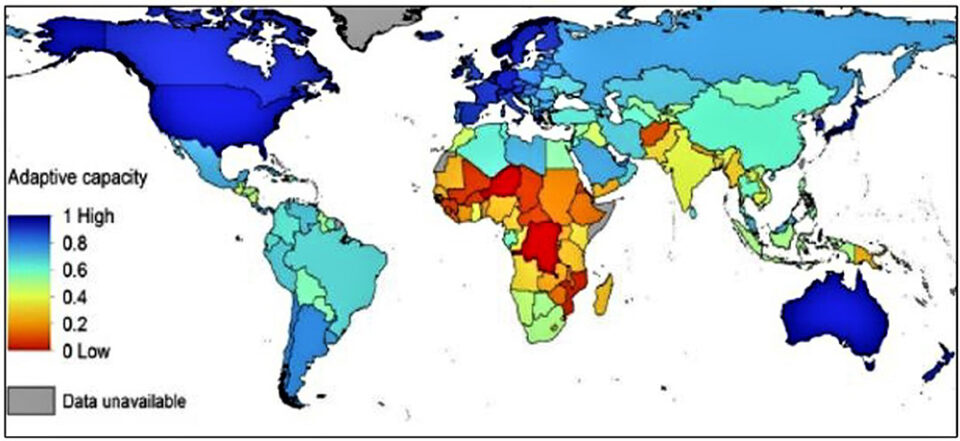Study reviews and discusses implications for sustainability, climate change mitigation and adaptations

Climate change is now considered a risk to global food production and a major threat to the quality and quantity of production. Food security, particularly access to dietary protein, is increasingly being threatened by the predicted effects of climate change. The effects of climate change on aquaculture have been extensively studied and reviewed both at regional and global scales because of the sector’s significant contribution to global food security, nutrition and livelihoods. Most studies, however, tend to explore the negative effects of climate change projected on aquaculture while giving far less attention to the positive ones that are very critical for adaptation strategies and are largely biased toward showing how climate change will affect aquaculture production systems while leaving other components of the value chain unclear.
Furthermore, the currently available literature reviews do not investigate how the sustainability of the aquaculture sector could be affected by the projected change in the climate. Such information is very useful for identifying appropriate interventions to climate change aiming to sustain livelihood sources for aquaculture-dependent communities.
This article – adapted and summarized from the original publication (Maulu S. et al. 2021. Climate Change Effects on Aquaculture Production: Sustainability Implications, Mitigation, and Adaptations. Front. Sustain. Food Syst. 5:609097) – presents the results of a comprehensive literature review related to “climate change and aquaculture” from scientific, reputable and internationally recognized journals and websites, focusing on the most recent (not more than 10 years back) and relevant literature. It discusses the effects of climate change on aquaculture production and sustainability implications, presents some mitigation and adaptation options that may have a wider application as well as challenges to successful adaption and suggests prospects for future development.
Quantifying greenhouse gas emissions from global aquaculture
The effects of climate change on aquaculture and implications on sustainability
Climate change effects on aquaculture production are both direct and indirect. The direct effects include influencing the physical condition and physiology of finfish and shellfish stocks in production systems, while indirect effects may occur through altering the primary and secondary productivity, and structure of the ecosystems, input supplies, or by affecting product prices, fishmeal and fish oil costs, as well as other goods and services needed by fishers and aquaculture producers. The various ways through which climate change will affect aquaculture production and implications on the sustainability of the sector are presented in detail in the original publication.
Aquaculture production does not occur in a vacuum but has important links with other food production systems. Researchers have observed that to sustainably meet the ever-increasing demand for aquatic products, there is a need to recognize the strong link existing within and across the goals of fisheries, aquaculture, and agriculture systems. Fig. 1 provides a simple illustration of how greenhouse gas (GHG) emissions will affect aquaculture production as well as the contribution of capture fisheries, aquaculture and agriculture activities to climate change.

Although aquaculture activities, such as power input, transportation and feed production are considered the main pathways of the sector’s contribution to GHGs, its contribution is relatively small despite being significant when compared to other food production sectors. For example, the contribution of aquaculture to global GHGs, particularly carbon dioxide (CO2), emissions in 2010 was estimated at 385 million tons or about 7 percent of the agricultural sector’s contribution that year.
Recent estimates by the Intergovernmental Panel on Climate Change [IPCC, the United Nations body for assessing the science related to climate change] show that agriculture, forestry, and other land uses contributed about 13 percent carbon dioxide, 44 percent methane and 82 percent nitrous oxide emissions from anthropogenic activities for the period 2007 to 2016, accounting for 23 percent of net anthropogenic emissions of GHGs. It is estimated that 45 percent of the total net contribution by agriculture comes from animal production, particularly livestock farming, which contributes mainly methane, carbon dioxide and nitrous oxide, making it the sector’s largest contributor.
On the other hand, aquaculture’s main GHG emission is carbon dioxide through the normal respiration of aquatic animals. However, there is still a gap in existing knowledge regarding the pathways and contribution of aquaculture production to global GHG emissions, which requires further investigation. The contribution of fisheries, mainly carbon dioxide to the net food production GHG-emission contribution was estimated at 4 percent in 2011, while the percent increase of emissions from the global fisheries industry was estimated at 28 percent between 1990 and 2011, mainly due to increased fishing operations.
Sustainability, despite many definitions available, can refer to the management of financial, technological, institutional, natural and social resources to ensure a constant supply of human needs, not only for the present but also for future generations. Therefore, for aquaculture to be sustainable, it must survive throughout generations.
According to Valenti et al., the sustainability of aquaculture systems may be assessed using three sustainability indicators: environmental, economic, and social indicators. Environmental sustainability indicators include the efficient utilization of natural resources, pollution prevention, and biodiversity conservation. Economic sustainability focuses on the efficient use of financial resources, economic feasibility, resilience and the capacity to absorb negative external expenses, and generation of funds for re-investment; while social sustainability focuses on the capacity of aquaculture to provide benefits to communities, such as food security, employment, equality of income and opportunity distribution and inclusion of vulnerable populations.
However, currently available literature on aquaculture sustainability has largely focused on environmental sustainability, with far less attention being given to the other two equally important dimensions. Future studies should critically investigate how climate-induced changes may affect the social and economic aspects of aquaculture production sustainability.
Numerous reports have emerged showing that climate change effects on aquaculture may vary depending on geographical areas, economy, climatic zones, production systems and cultured species. Several other studies have also shown that small-scale farmers will be more affected by climate change risks due to increased production costs in farm management and lack of support systems to recover from the effects compared to large-scale producers. It is important to note that climate change effects will not only affect aquaculture production systems, but also the entire value chain. Hence, climate change could be more viewed as an involuntary risk that creates vulnerability on the socio-economic development and raises stress especially on food demand and supply as well as the livelihood system of the farmers.
The predicted elements of a changing climate that threatens production and sustainability of the aquaculture sector include rising temperature, ocean acidification, diseases and harmful algal blooms (HABs), changes in rainfall/precipitation patterns, sea-level rise, the uncertainty of external input supplies, changes in sea surface salinity and severe climatic events. These elements will not affect aquaculture production equally, since, like any other farming practice, the sector is defined in time, space and size, and therefore the elements have a fair degree of maneuverability while affecting fish populations at different life cycles as well.
Mitigation and adaptation options
Climate change-related risks to health, food security, livelihood, water supply, human security and economic development will increase under current projections. In the face of such risks, both industry and communities will need to mitigate and adapt to the changing climate by taking advantage of new opportunities emerging from altered resources. Mitigation and adaptation may help prepare the farming communities, ecosystems and populations, in general, to build resilience and deal with climate change as effectively and efficiently as possible. Mitigation focuses on reducing or reversing the rate of climate change. This involves mainly reducing GHGs emissions with a special focus on carbon dioxide emissions which account for more than 60 percent of human enhanced increases.
According to the IPCC in 2018, reductions in carbon dioxide emissions may be achieved through a combination of new and existing technologies and practices, including electrification, hydrogen, sustainable bio-based feedstocks, product substitution and carbon capture utilization and storage. In aquaculture, producers and other stakeholders may play a significant role in mitigating climate change effects by making necessary adjustments in their production practices aimed at minimizing the emission of GHGs. Specifically, this includes the use of environmentally friendly practices and technology, such as solar energy, proper feeding practices, and sustainable wastewater management to minimize air and water pollution.
Adaptation focuses on building resilience to the consequences, and the capacity to utilize emerging opportunities sustainably and ethically. But it is not a one-size-fits-all situation, considering the dynamics of vulnerability and exposure and their linkage with the socio-economic and sustainable development of various sectors. According to the IPCC, successful adaptation in a changing climate will depend on the adaptive capacity of the producers in a given nation or region. For example, more severe effects have been predicted on the producers in developing countries due to low adaptive capacity (Fig. 2).

Diversification of livelihoods may be one of the keys to successful adaptation because it gives the producers options from which they can derive their livelihoods and build appropriate resilience from climate change impacts. It involves combining aquaculture production systems with other sectors, such as agricultural systems, either integrated or as separate systems. Diversifying livelihood sources is extremely useful, especially in some regions or countries where fish production is predicted to decline, while agricultural production is expected to increase.
However, successful diversification requires that government policies provide incentives for efficient utilization of resources, equity and protection of the environment. Moreover, improving livelihood diversification among aquaculture producers requires integrating indigenous knowledge with government interventions. Unfortunately, the major factor affecting the adaptive capacity of farmers, households and communities at large is their access to, control over, and ability to use productively the natural, human, social, physical and financial assets, i.e., the livelihood capital.
Aquaculture producers may also benefit from shifting to aquaculture species, techniques or areas that are less vulnerable or are more resilient to a changing environment and resources. For example, integrated multi-trophic aquaculture (IMTA) systems are more environmentally friendly, sustainable and economically rewarding as well as more resilient to changing climate compared to monoculture because it combines finfish farming with other species. Aquaculture producers may also make use of altered resources, such as land by practicing new farming systems.
The utilization and incorporation of local and indigenous knowledge in adaptation strategies have also been shown to offer effective adaptation to climate change. While scientific understanding provides a generalized insight regarding climate change and its potential effects, indigenous knowledge may provide specific details about the physical environment, infrastructure systems, livelihood status, behavior, governance organization and other attributes that are crucial for managing community resources. For example, the use of traditional methods and indicators to predict changes in weather patterns (temperature, rainfall, humidity, etc.) may help the producers prepare for expected changes and build resilience. Information on how such incorporation has been utilized in aquaculture production is still largely unknown. However, in other sectors, such as agriculture, it has successfully been used by farming communities.
Perspectives
This review highlights the potential effects of climate change on aquaculture production and its implications on the sector’s sustainability. Despite being considered by many as the only solution to meeting the continued rise in demand for aquatic products globally, the aquaculture sector is increasingly being threatened by human-driven climate change effects that are both a present and future reality.
Additionally, although climate change is a global food production risk, the associated risks for aquaculture are expected to differ across geographical or climatic zones, national economies, water and environment, production systems, the scale of production, and cultured species. To build resilience and sustain production in a changing climate, aquaculture producers must adapt to the available options in the short term while mitigating the effects by making necessary adjustments in their production practices in the long term.
This review has addressed important aspects of climate change and aquaculture production; however, several limitations were identified that presents important areas for future consideration. In this regard, our review is limited to the production and input supply stages of the aquaculture value chain and does not address the other important stages, such as trade and transportation, processing and consumption of the products.
In addition, within the production stage of the value chain discussed, it was not clear how various species of economic importance at different life stages will respond to a changing climate. Information on this would be useful for adaptation strategies that may require the producers to shift to species that may be more resilient to the change in the climate. Also, many studies considered were biased toward environmental dimensions of sustainability while neglecting the social and economic aspects.
As the aquaculture sector continues to grow while climate change becomes clearer, there is a need to embrace a holistic approach in projecting climate change effects on aquaculture and in addressing these impacts so that mitigation and adaptation strategies would be more effective. However, this will require developments in research, especially in more vulnerable regions due to poor adaptive capacity, and poorer economies would benefit from more international cooperation.
Now that you've finished reading the article ...
… we hope you’ll consider supporting our mission to document the evolution of the global aquaculture industry and share our vast network of contributors’ expansive knowledge every week.
By becoming a Global Seafood Alliance member, you’re ensuring that all of the pre-competitive work we do through member benefits, resources and events can continue. Individual membership costs just $50 a year. GSA individual and corporate members receive complimentary access to a series of GOAL virtual events beginning in April. Join now.
Not a GSA member? Join us.
Author
-
Sahya Maulu, M.Sc.
Corresponding author and Ph.D. student
Centre for Innovative Approach Zambia, Lusaka, Zambia; and Wuxi Fisheries College, Nanjing Agricultural University, Wuxi, China
Editor’s note: This article has nine co-authors, but only the corresponding author is listed.
Tagged With
Related Posts

Aquafeeds
Bridging the omega-3 gap with methane, microalgae
Innovation is leading to new ingredient options for renewable sources of omega-3 fatty acids. But Replicating long chain fatty acids is a tall order, Advocate contributor Lisa Duchene discovered.

Responsibility
Quantifying greenhouse gas emissions from global aquaculture
Quantifying greenhouse gas emissions for global aquaculture indicated that the industry accounted for only 0.49 percent of anthropogenic GHG emissions in 2017.

Responsibility
Greenhouse gas emissions from aquaculture
To quantify the carbon dioxide and methane fluxes in tropical earthen ponds, the authors used freshwater prawn farming managed according to different strategies as a model.

Responsibility
Environmental groups urge UK fleet to achieve ‘climate smart’ fisheries
Three environmental NGOs publish “Shifting Gears” report to push post-Brexit UK fisheries to address climate impacts.


